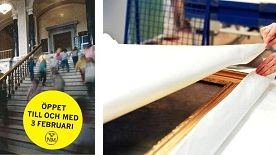
Press release -
Art goes on tour during Nationalmuseum renovations
Last spring, the Swedish government gave the go-ahead for planning work to start on the renovation of Nationalmuseum. Next year, the collections and museum operations will temporarily vacate the building. Members of the public, both in Sweden and abroad, will still have the opportunity to experience the art thanks to collaborations, touring exhibitions and temporary venues.
Until 3 February 2013, visitors can still enjoy an extensive range of programming and exhibitions in the Nationalmuseum building, culminating in a spectacular final weekend on 2–3 February. The building will then close to prepare for renovations.
- An exciting time lies ahead. We’ll have a little more freedom during the renovation period, and we’ll be partnering with other museums and galleries in Sweden and abroad. We now have the opportunity to increase the number of venues showing our collections, and we’re honoured that so many of our fellow museums are willing to collaborate, says Berndt Arell, Director General of Nationalmuseum.
Nationalmuseum has a mandate to promote interest in art throughout Sweden, and to support art in the regions. At some venues, Nationalmuseum’s collections will meet pieces from local collections. What’s more, a new art hotspot will be created when Nationalmuseum takes up temporary residence as the guest of Konstakademien (The Royal Swedish Academy of Fine Arts) at Fredsgatan 12 in Stockholm. This will be the venue for exhibitions and programs for all ages. The opening exhibition, starting on 13 June, features a much loved artist: Carl Larsson. Friends and Foes. Occupying three galleries, the exhibition will include works from Nationalmuseum plus works on loan from private collections and other museums.
The renovation project is intended to create the conditions for a modern museum to flourish in the Nationalmuseum building while preserving the integrity of its architectural heritage. The new Nationalmuseum will be an open, visitor-friendly place where art can be experienced on both a large and a small scale, in a sustainable building. The long-awaited renovation will better equip the building both to welcome visitors and to protect the art treasures that make up Nationalmuseum’s collections.
Further information
Lena Munther, Director of Communications
lena.munther@nationalmuseum.se, +46 8 5195 4465
Press images
www.nationalmuseum.se/pressroom
Collaborations, exhibitions and venues 2013–14
Even when the building is temporarily closed, Nationalmuseum can continue to perform its mission: to welcome visitors and to promote interest in older art and in applied art and design up to the present day.
Spring 2013
Nationalmuseum building open to the public until 3 February.
The National Property Board will carry out projection until construction documents.
The Four Seasons, Jamtli, Östersund
Slow Art, Kalmar Castle, Kalmar
Nordic Art – The Modern Breakthrough, Groningen, the Netherlands
Carl Larsson. Friends and Foes, opening exhibition at Konstakademien, Stockholm
Autumn 2013
Nordic Art – The Modern Breakthrough, Munich, Germany
Anders Zorn, San Francisco, USA
Slow Art, Falkenbergs museum, Falkenberg
Spring 2014
Near & Far, Västerbottens museum, Umeå, for the duration of Cultural Capital Year 2014
Major exhibition on the Baroque in partnership with Kulturhuset, Stockholm
The Four Seasons, Ystads konstmuseum, Ystad
History in Pictures, Göteborgs konstmuseum, Göteborg
Autumn 2014
The Artist’s Trade, Jönköpings läns museum, Jönköping
Alexander Roslin, Enschede, the Netherlands
The Dutch Golden Age, Budapest, Hungary
Pehr Hilleström, Helsinki, Finland
Facts and background
Nationalmuseum’s history
Built 1866 for the Swedish government. Architect: Friedrich August Stüler. Stüler’s firm belief that architecture and decoration could enhance the experience of art is central to the Nationalmuseum building’s design. The galleries vary in size, decor, colour scheme and lighting.
Background to the renovations
For decades, the building has been constantly repurposed and adapted to the museum’s changing and growing requirements. One layer of modifications has been piled on top of another. However, the building has never been thoroughly renovated and does not meet today’s accepted international standards of safety, climate control, fire safety, working environment and logistics. The renovation will bring it up to modern operational and regulatory standards.
The collections
The collections contain 700,000 artifacts: painting, sculpture, drawing and graphic art from the pre-20th-century period, and applied art and design up to the present day. The collections originated as royal art collections that were left to the state. Until the 1990s, entire collections were gradually transferred to other bodies, forming the basis of or becoming a part of museums such as the National Historical Museum, Gustav III’s Museum of Antiquities, the Museum of Mediterranean and Near East Antiquities, and the Moderna Museet. Some other works were transferred to the Royal Library.
Our mandate
Nationalmuseum, incorporating Prins Eugens Waldemarsudde, is a central government agency reporting to the Ministry of Culture. Our mandate is to preserve cultural heritage and promote art. The museum building on Blasieholmen in Stockholm receives 400,000 visitors annually, a third of whom come from outside Sweden.

